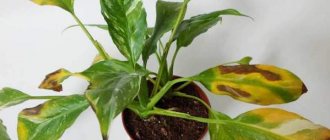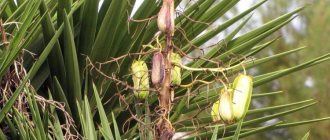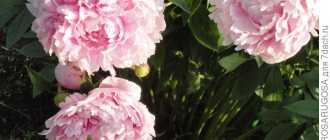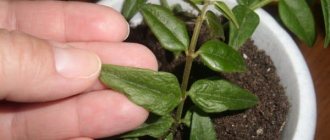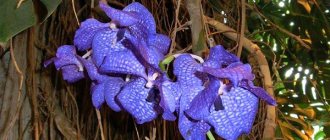A low indoor perennial plant, Latin name Spathiphellum Chopin, obtained by crossing Wallis spathiphyllum with other species. Its predecessor, Spathiphyllum Wallis, was brought by the scientist Wallis from Venezuela, and with the help of breeding work, a new species of Chopin was developed, which is particularly unpretentious to living conditions.
The second name of the plant is Chopin, derived from the pronounced Latin name. Another name for the plant is “female happiness” - for support and assistance in the lives of women and girls, as esotericists believe. For the plant to really help, it is advisable to receive this flower as a gift.
Description and photo
The plant is 35 centimeters in height, the leaves are rich green, glossy. They have an oval shape, entire edges, with clearly visible veins, because of which the leaf appears wavy, and a pointed end, 20-25 centimeters in length, and up to 5-6 centimeters in width, collected in a basal rosette. Planted on green petioles up to 18-20 centimeters, widening at the top and coming out almost from the ground. The flowers are light cream in color, collected in an inflorescence spadix, covered on the outside with a white, slightly elongated perianth.
Chopin differs from other types of spathiphyllums in the pleasant aroma of flowers - rich in the morning and decreasing in the evening.
Spathiphyllum Sensation
This spathiphyllum hybrid can easily be considered one of the most decorative and spectacular. Spathiphyllum Sensation bushes can reach one and a half meters in height. This makes the variety one of the largest among existing indoor varieties.
The plant has large attractive leaves of a dark, shiny color and a length of 40 to 80 cm. The large inflorescences of Spathiphyllum Sensation also greatly benefit from other similar varieties. Only appearing above the foliage, the perianths are white. Then they gradually turn green and merge into the general background. The ear is large, smoother than that of other plants. At the same time, the spathiphyllum flower, as in the photo, lasts for a very long time.
Among other tall varieties of spathiphyllum, one should note Sweet Silvio, a hybrid origin with graceful inflorescences and lush bushes up to 75 cm high. Against the background of this large variety, Strauss spathiphyllum plants, 30 cm in height, look especially miniature.
Is the plant poisonous or not?
The plant contains poisonous juice that can cause irritation and burns of the mucous membrane of the mouth and esophagus, as well as poisoning, and if the owner has a tendency to allergies, then it can cause a severe allergic reaction.
It is recommended that all work on caring for, replanting, and pruning the plant be carried out wearing protective gloves and goggles.
Allergies can manifest themselves as:
- red spots;
- rashes in the form of small red pimples;
- itching and general swelling;
- runny nose;
- the most severe symptom is swelling of the larynx, known as angioedema.
To reduce the allergic reaction, you need to take detoxifying drugs like activated charcoal and take antihistamine tablets. But it is better to consult a doctor immediately .
Poisoning manifests itself:
- rapid breathing;
- rapid heartbeat;
- severe headache;
- slower reaction;
- sweating;
- general weakness.
To provide assistance to the victim, it is necessary to call a doctor, or hospitalize the patient in a nearby hospital .
If your pet is injured
Cats very often touch the soil in pots, and in winter they often gnaw leaves. It is worth paying attention to such symptoms as:
- lack of physical activity;
- your pet just lies there and doesn’t get up;
- he breathes quickly and hoarsely;
- the heart beats very quickly;
- a lot of saliva is produced.
You need to give the animal one tablet of activated carbon at the rate of one tablet per kilogram of weight and take the pet to the veterinarian.
Bloom
The plant blooms from the second year of life, from the end of March until the end of October inclusive. The flowers are small, collected in an inflorescence spadix, light cream in color, protected by a large perianth, white, sail-like. Blooms for 2-3 weeks.
After the flowers are pollinated and before the seeds begin to ripen, the perianth becomes green and remains that way for another couple of weeks. After pollination of the flower, a berry is formed, inside which a curved seed ripens.
Where to buy Chopin? What is the price?
You can purchase Chopin spathiphyllum at a flower shop or through an online store. The cost of a flower is determined by the age when the flower is planted - a seedling or an adult plant.
A flowering plant with a 15 centimeter pot will cost from 250 rubles or more , a small seedling in a 9 centimeter pot costs from 180 rubles. You can just buy a seedling, it costs less - from 50 rubles.
Use Cases
Chopin can often be seen in offices, where it is used not only as an element of room design, but also as a natural humidifier and air purifier from harmful substances and dust. The variety is also grown in apartments, since this cute flower evens out the energy of the home, gives harmony to its inhabitants and, according to popular belief, brings happiness to the fair sex. Considering the fashion that has emerged in recent years for potted flowers given as a gift, spathiphyllum would be appropriate as a sign of attention to a relative or friend.
Landing
In order to plant a plant correctly, you must select a pot; its size cannot be larger or smaller. The pot should be 3-4 centimeters larger than the spathiphyllum roots . Need to:
- Place expanded clay on the bottom and sprinkle with a little nutritious soil.
- Place the seedling in the pot and, holding it, fill it with soil to the edges of the pot.
- Lightly crush and water.
Soil for planting indoor flowers can be purchased at the store, or you can prepare it yourself. To do this, you need to mix sheet soil, turf, peat, and sand in equal parts.
Seeds
To plant a plant with seeds, you need to prepare a tray or container with a wall depth of no more than 3-4 centimeters. Step-by-step instructions for growing spathiphyllum from seeds :
- Pour the prepared soil into the prepared container, having previously calcined it.
- Scatter the seeds, or press the seeds into the ground by hand. Water everything, cover it with specially prepared transparent glass, and place it on the windowsill.
- Continue to water and sometimes ventilate, avoiding waterlogging and the appearance of mold fungi.
- After the emergence of seedlings, continue watering and airing until the sprouts are 3 centimeters in height.
- Plant the seedlings in small cups and continue watering.
- When the seedlings reach a height of 6 centimeters, transplant them into slightly larger cups.
- After 12 weeks, transplant into permanent pots and place in a permanent place.
- After 2 weeks, we begin fertilizing with complex fertilizers.
Reproduction methods
Spathiphyllum can be propagated by seeds and cuttings. For some reason, gardeners rarely use the first option. Perhaps due to the fact that you have to wait a long time for the bushes to mature.
Seeds
Spathiphyllum flower - propagation at home
To propagate spathiphyllum with seeds at home, follow these step-by-step steps:
- Breathable soil is poured into the box.
- Seeds are laid out on the surface and covered with a thin layer of soil.
- The ground is sprayed with warm water from a spray bottle.
- The box is covered with transparent film or glass. Every day the shelter is removed for ventilation.
When the first shoots appear, the film is removed. When the seedlings have 2-3 leaves, they are transplanted into miniature containers.
By cuttings
Propagation by cuttings is carried out in the spring during transplantation of an adult plant. During the year, children grow around the bush, which are separated and planted separately. The procedure is carried out as follows:
- Drainage is placed at the bottom of the pots.
- Fill ⅔ with earth.
- Seedlings are placed in the middle and covered with soil.
- Lightly compact the soil and water.
- Excess water is poured out.
For your information! Seedlings can be covered with film. When they take root well and a new leaf appears, the cover can be removed.
Propagation of spathiphyllum by cuttings obtained by dividing the bush
Caring for a plant at home
Spathiphyllum Chopin is a specially bred hybrid that is easy to care for.
- Temperature . As an inhabitant of tropical countries, spathiphyllum loves warmth and its comfortable temperature will be +18-24 °C. The critical temperature at which a flower can die is +10 ºС.
- Lighting . The plant tolerates shade and partial shade well, but at the same time the decorative properties of the plant are lost, the green color becomes faded or disappears altogether. Direct sunlight burns the leaves. It is better to place the plant on the east or west side.
- Watering and humidity mode . It is necessary to water abundantly so that the soil does not become dry. Approximately once every two or three days in the summer, and once a week in the winter. With a lack of water, as well as with an excess, yellow and brown spots appear on the leaves, and the edges of the leaves dry out. For irrigation, use soft, room temperature water, standing for 5-6 hours. It is advisable to wash the leaves with a sponge or spray them at least once every 10 days.
- Fertilizer . Feed with complex fertilizers with a break of two weeks throughout the winter period. A month before flowering begins, it is necessary to switch to potassium-phosphorus fertilizers, which are necessary for normal budding and flowering.
- What to do if it doesn't bloom ? If spathiphyllum Chopin does not bloom at all, first of all you should pay attention to the size of the pot, then to the amount of fertilizer, it may not be enough, and to the temperature in the room.
- Trimming . Dry leaves and old flower stalks are regularly trimmed. This must be done carefully so that the plant juice does not get on your hands.
- Transplant . To replant an adult plant, you need to again pay attention to the size of the pot.
- Care during flowering . During the flowering period, abundant watering is required, you should pay attention to the leaves. Black spots appear on them if the roots rot - this is the most common disease of spathiphyllums. There is no need to feed the plant during flowering.
- Reproduction . Spathiphyllum Chopin can be propagated by shoots and seeds.
Transfer
Transplantation is an important procedure for this flower. According to the rules, it must be carried out once a year at least. It is advisable to transplant in the warm season, namely in the spring. Particular attention should be paid to the root system during the transplantation process. The fact is that it is a rather fragile part of the plant and even with minimal disruption of its integrity, the entire flower can die.
This is especially true for young shoots. In this case, it is recommended to replant “Chopin” together with a clod of earth - this significantly reduces the risk of causing any damage.
Important: the regularity of replanting varies for young and mature plants. Thus, “Chopin”, which has not yet reached the age of 4 years, needs annual replanting, and a more mature flower can be replanted once every 2–3 years.



